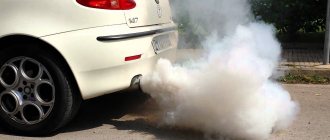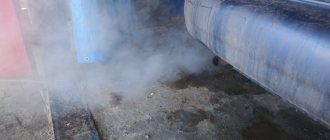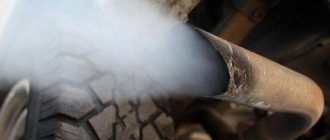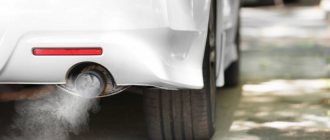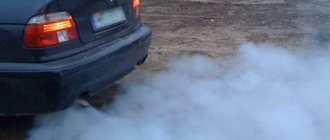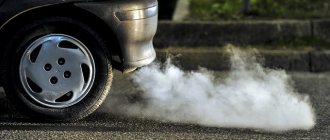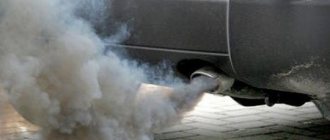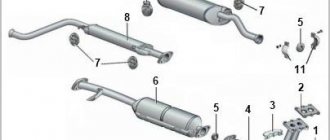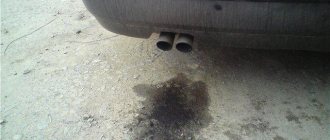Author: Evgeny Zhivoglyadov. Publication date: September 19, 2022. Category: Automotive equipment.
If a flame bursts out of the exhaust pipe of a car driving nearby, then there are two options for why this is happening: the vehicle is faulty and needs to be abandoned urgently, or the car enthusiast has seen enough films with beautiful cars and decided to become the owner of a “high-power racing unit.” The second option is much more common. The desire to attract the attention of others pushes car owners to create tuning, which is called “dragon language”.
It’s worth saying right away that this is a purely visual effect, which in no way indicates the power and capabilities of the machine. This is just a spectacle, lasting a few seconds and nothing more. To be completely honest, such tuning not only does not bring any benefit, but also completely harms the car and can be extremely dangerous for the life of the driver himself. But, if the desire to get a “tongue” of flame is irresistible, then you need to do everything correctly and understand all the intricacies of recreating such styling.
Flame emitted from the muffler
Fire from the exhaust pipe happens in two cases: either in case of some malfunctions that should be fixed immediately, or to demonstrate your car. The flame rushing out, or, in other words, the “tongue of the dragon” is a spectacle that guarantees everyone's attention, causing a lot of emotions. It gives the impression of being powerful, sophisticated and cool like a racing car. This effect does not indicate the power of the engine at all, but it leaves vivid emotions and is undoubtedly suitable for any kind of show or simply for those who like to stand out. Racing cars have a completely short and straight exhaust system, which is not able to completely extinguish the burning gases, which contributes to the appearance of flames. In ordinary cars, the design of the exhaust system is somewhat different, and besides being spectacular and entertaining, the “dragon tongue” does not bring any benefit; on the contrary, the frequent use of a bursting flame harms the car.
By taking all precautions, you can achieve such an impressive effect yourself, that is, make a “monster” out of your car with your own hands by installing a homemade special device that ignites the remaining gasoline at the outlet of the exhaust pipe, or you can purchase and install an electronic system. If you do not know how to handle electronics, it is better to have it done by a professional.
Before installing the equipment, do not be lazy to diagnose the fuel and exhaust systems; the car’s power supply must be intact and in good working order.
To install the system, the following conditions are required:
- gasoline engine (carburetor or injection);
- straight-through muffler;
- lack of exhaust gas neutralizers.
Curious incidents with fire cars
Installing your own fiery exhaust on a car is an opportunity to make the car start challenging and daring. But don't forget about safety. There are those who want to save on installing a flame exhaust and do it themselves, without even basic skills and knowledge. It's good if everything is installed correctly.
But accidents often occur when car bumpers or tires catch fire. Only after this does the realization come that it was not worth saving on installing the system. When a car catches fire from a fire in the muffler, you may panic and think that if you drive faster, the flame will immediately go out. But in practice, the flame only burns hotter.
The simplest scheme to achieve the “dragon tongue” effect
Making fire from a muffler is quite simple. When the car is working properly, the exhaust gases cool down as they pass through the exhaust pipes, which means there is nowhere for the fire to appear, so a special spark plug is installed at the end of the exhaust pipe, which ignites a small portion of the gasoline that is not burned in the cylinders.
In order for the spark plug to work and create a spark, it must be connected to a simple pulse generator. Using a switch (button) located in the car's interior, the spark plugs are turned off so that not all the fuel in the cylinders burns and some of it ends up in the exhaust pipe. The pulse generator starts, supplying a spark to the additionally installed spark plug. The effect is ready, flames burst out from the exhaust pipe.
To avoid an explosion or failure of the exhaust system, when using manual gasoline supply, the main thing is not to overdo it so that too much of it gets there.
Safety precautions
Anyone who undertakes tuning the exhaust system must be aware that any manipulations with fuel are extremely dangerous. Any mistake is highly likely to cause an explosion. Therefore, such experiments are not recommended for those who do not have the necessary knowledge and skills.
Finally, here are some tips for those who decide to remake their car - perhaps they will help you save your life and health:
- Do not put too much fuel into the exhaust system - this may cause an explosion;
- The effect of flames from the exhaust pipe is not allowed if the car is moving - you can surprise others only during deceleration;
- Carefully ensure that fuel is injected into the exhaust system without leaks - this will lead to an explosion;
- Demonstration of the effect is permitted only outdoors and only at those moments when there are no people or animals in the immediate vicinity;
- The duration of the effect can be no more than two to three seconds;
- It is strictly forbidden to turn on the effect while driving on highways and public roads - this can lead to serious accidents.
If you look at it, by and large, this effect can be demonstrated to friends or spectators before the start of a car race. In this regard, it is worth considering whether it is worth spending precious time and money, putting your life and car at risk for the sake of a few seconds of delight from your friends or spectators in the stands.
Author: Semin Viktor Yurievich
Education: Samara Road Transport College. Telecommunications and electronics engineer. Second category driver/car mechanic. Skills in repairing domestically produced cars, chassis repair, brake system repair, gearbox repair, bodywork...
How to put such a scheme into action?
To install an additional spark plug in the muffler (in the last pipe of the exhaust system, after the resonator):
- a hole is made to secure the spark plug bushing using cold welding;
- the spark plug is screwed in;
- put on the spark plug cap.
Nearby there is a mount for the ignition coil (high-voltage transformer). The coil must be independent, turned on with a separate button. All elements are connected with a special wire.
To prevent some of the gasoline from getting into the working cylinders, but into the exhaust pipe, you should unscrew one or two spark plugs and put a plug in their place. After the demonstration is completed, the candles are put back.
What cars is it suitable for?
First of all, owners of diesel cars will have to forget about this idea. In such systems it is simply impossible to create the necessary condition. In diesel engines, the combustible mixture ignites under the influence of compression, while the “dragon tongue” requires forced ignition.
You also need to be careful for those whose cars are equipped with additional filters, partitions, neutralizers and other additions that manufacturers install in order to prevent air pollution. By and large, the “dragon tongue” is easiest to install on a direct-flow exhaust system.
If the car meets these requirements, then you need to make sure that its fuel and exhaust systems are in order, and that the power supply is not disrupted and is working correctly. Only in this case can you proceed to installation of the system.
Connecting an additional transformer
For safety reasons, the battery is disconnected before laying the wire.
Additionally, three wires with a cross-section similar to the wires going to the installed transformer are tightened.
From a conventional ignition coil, one wire goes to an additionally installed terminal, the second is laid to the car’s dashboard, the third connects the dashboard to the new transformer.
Next, a toggle switch is installed on the dashboard, to which pre-prepared wires will be connected.
To avoid engine imbalance and increased wear of piston system parts, the device should be used correctly:
- engine starting;
- warming up the engine to operating temperature;
- engine speed should reach 3500 rpm;
- pressing the system power button for 2–3 seconds.
To prevent the engine from stalling, turn on the ignition key when reducing speed.
Precautionary measures
It is recommended to proceed with extreme caution when installing the system. There is a high risk of compromising the integrity of the exhaust system. It is necessary to carefully control the amount of freely flowing gasoline to avoid the occurrence of an explosive situation. Also, to ensure the safety of all engine parts and the exhaust system, it is necessary to comply with the time limits: the flame should not go out for more than three seconds.
Displaying special effects with fire is permissible only in a free and open area, away from people and various objects that could ignite. The car must be immobilized when performing such a stunt. The appearance of “dragon tongue” on public roads is strictly unacceptable.
The flame can be about half a meter, this can damage the paintwork of the car. The simpler the flame production system is, the more damage is done to the car. Therefore, it is better to give preference to the electronic version. When performing “flames”, you should not get carried away and perform the trick often in order to avoid car damage. Always follow safety precautions, then the fire show will bring only positive emotions.
Steel chimney
Chimneys made of steel have extremely high thermal conductivity. As a result, there is no need to heat such a chimney for a long time. It heats up quickly and without much hassle. Also, its advantages include its low cost and the smoothness of the internal surface of the chimney. There is practically nothing for soot and flammable sediments to cling to on the inner surface.
However, studies have shown that the smooth surface of chimneys does not always have a positive effect on the performance of steel chimneys and fire safety. What we have? We often have the problem of overheating of steel chimneys. So what is the reason why traces of fires are so often visible on the roofs of buildings?
If the chimney is designed correctly, then problems at the floor level should not arise. A steel chimney is a source of fire hazard if it is not used for its intended purpose, the steel has insufficient heat resistance or combustion products burn out as they exit the pipe.
We invite you to familiarize yourself with the Heat exchanger for a sauna stove with your own hands || How to connect a tank to a heat exchanger
Conclusion
The effect, also called the dragon's tongue, which consists of the appearance of a flame behind the car, is decorative and is suitable for demonstration at all kinds of shows or festivals and other festive events. A similar phenomenon occurs due to incomplete combustion of gasoline in the engine cylinders and its subsequent ignition in the exhaust system. As an entertainment effect, this is quite acceptable if certain safety requirements are met, but you should not get too carried away with it. Its prolonged and frequent demonstration can lead to damage to the engine and the vehicle as a whole. » alt=»»>
Folk repair methods and features of their application
If the muffler is burnt out, you can use traditional repair methods (some mentioned above):
Special tape.
The exhaust system includes pipes and tanks. Of these elements, tanks are more susceptible to burnout, which is due to the accumulation of condensate and “torsion” inside the gases.
In addition, the thickness of the metal frame is lower here, which is also an additional factor.
Situations are possible when pipes are damaged due to a mechanical impact on a stone or in the event of driving into a hole at speed.
A crack may also appear in the event of a sudden change in temperature (when driving into a puddle). If the inspection shows damage to the pipeline, and the defect itself is small, thermal tape is used.
Its advantage is to ensure tightness and high speed of repair.
On the other hand, it does not provide sufficient rigidity, so the damage will definitely return.
Sealant.
Many car owners are confident that the best way to restore is to use a special sealant that ensures the rigidity of the joints and the joining of different elements.
It can also be used when installing a new muffler gasket or when installing connecting units with non-standard dimensions.
To prepare the composition, you need to take a piece of material, knead it (it should take the shape of plasticine), and then seal the damaged area.
Next, the treated area is leveled using a spatula. After 24 hours, you can get behind the wheel and go about your business. In addition, this method can extend the life of the exhaust system.
The main thing is to choose the right type of cold welding - it must withstand high temperatures.
Sealant may come in handy in one other situation. So, if the flange connecting two elements of the system is bent, or the sealing joint has lost its tightness, the damaged joint can be treated.
Insulating material.
You will need a piece of asbestos (loose or sheet), asbestos thread and copper wire. To soften the material, liquid glass is added, after which the burnt-out part of the muffler is filled with the mentioned mass.
The repair site is tightly wrapped first with asbestos thread, and then with copper wire.
The advantage of this method is the high speed of repair and the ability to delay major restoration work.
Shots on injection engines
Basically, this problem occurs quite rarely on injection-type engines. Even if such a malfunction occurs, then, as a rule, the reason may be hidden behind the same reasons as in a carburetor engine. The only exception to the rule may be a malfunction of the sensor contacts. This is what sometimes occurs on injection engines more than other cases. It is almost impossible to independently identify such a problem. Therefore, immediately when popping noises appear from the muffler, it is reasonable for the owner of a car with an injection engine to seek help from specialists. Only diagnostics will allow you to accurately determine the problem.
The video will explain why popping noises occur from the muffler:
Extraneous sounds in the muffler are a clear sign of a malfunction in one or more engine systems. Let's look at why the muffler shoots and what driving with such a malfunction can lead to, as well as how to independently diagnose the cause. To understand why shots occur in a silencer, you should start from the very basics.
Aggregate method
Recently, the aggregate method has become increasingly widespread, which consists of installing additional equipment that allows the engine to warm up under standard conditions. In other words, to achieve the goal, there is no need to resort to any significant additional manipulations.
Modern manufacturers offer a wide variety of devices to heat the oil. However, despite the independent technical solutions, they all have one common operating principle and a single device, which consists in the use of electrical energy and a special heating element mounted in the engine crankcase.
The heating element (heating element) is located in the crankcase in such a way as to be constantly immersed in engine oil. Otherwise, the heating element will quickly fail. If necessary (lower temperature), before directly starting the engine, a direct or alternating electric current (12, 24 or 220 V) is supplied to the heating element, which helps warm up the oil and normal engine starting.
As a rule, heating elements have one drawback associated with the uncontrollability of the heating process. The temperature of the oil in the crankcase can reach a critical point and it will boil. This can be avoided by using a special thermostat, which is used in conjunction with a heating element to turn it off when the required temperature is reached. Some modern heating elements have a self-regulating operating algorithm, eliminating the need to use a thermostat.
Reasons for the appearance of extraneous sounds in the exhaust pipe
So why is the car shooting? There is only one answer to this question - fuel combustion occurs in the exhaust tract. Despite the fact that the main purpose of the exhaust system is to reduce the sound of exhaust gases, the line from the combustion chamber to the muffler is an excellent conductor of sound. Therefore, when explosive ignition of fuel inside the exhaust system or opening of the exhaust valve, when the main phase of combustion of the fuel injection mixture in the cylinder has not yet ended, the sound is well transmitted to the environment in the form of shots and loud bangs.
So, if the engine starts firing at the muffler, then the search for causes should begin with the following factors:
- Ignition too late. In this case, the exhaust stroke begins when the mixture has not yet completely burned out, and therefore significant pressure remains in the cylinder. When the valve opens, pressure breaks into the exhaust tract, causing a pop;
- Incorrect timing leads to the same consequences as too late ignition. The exhaust valve opens too early. The timing phases are adjusted using marks located on the crankshaft pulley and camshaft gear;
- over-enrichment of the mixture. Let us remind you that the normal ratio is 14.7 portions of air to 1 portion of fuel. At power modes, when the main goal is to get maximum output, albeit at the expense of consumption and harm to the environment, the ratio can become 12/1. But excessive over-enrichment of TPVA leads to the fact that the combustion process in the cylinder takes too long. Prolonged combustion is explained by the lack of the proper amount of oxidizing agent (air). As a result, it simply does not have time to burn out until the moment when the exhaust stroke begins and the corresponding valves open. The danger also lies in the fact that unburned mixture can accumulate in the exhaust system. The hot surface subsequently ignites the unburned fuel, producing a loud bang from the exhaust pipe;
- incomplete combustion of the mixture, resulting in the accumulation of unburned fuel in the exhaust system. The reason for this phenomenon may be not only late ignition, but also a weak spark. The malfunction should be looked for in the ignition system, first checking the gap of the spark plugs, the degree of erosion of the electrodes, and the presence of carbon deposits.
Incomplete combustion of TPVS should be corrected in a timely manner.
Where is it used?
As mentioned earlier, most often such a pyrotechnic show is used during various automoto shows, car festivals and car enthusiasts' gatherings. In some cases, a similar effect is also used in circus performances.
Video: flame from the muffler
It is not often seen in everyday life. Firstly, the vehicle must be specially converted for these purposes. Secondly, this is not entirely dangerous and can only be done with a full list of safety measures. And finally, thirdly, the increased thermal load more sharply reduces the service life of the exhaust pipe and other elements that are connected to it.
Physics of the process
Now we will try to answer the question: “How to make a flame from a muffler?” The basis of any such special effect is the combustion process. For its physical implementation, 3 components are required:
- Availability of the required amount of oxygen
- Availability of fuel
- Presence of ignition source
see also
Comments 36
On supercharged sports cars, a fuel injector is installed into the exhaust manifold before the turbine. And at the moment of transition from one gear to another. To avoid a drop in turbine speed (turbo pit), fuel is injected. The fuel spontaneously ignites, an explosion occurs, and the turbine does not lose speed. But the price to pay is near—with “launch control,” turbines don’t last long. Explosions destroy the impeller. That's the whole secret. And the fact that home-grown racers “fart” with flames is simply that an ordinary spark plug crashes into the silencer and at high speeds, when the fuel does not burn completely, a regular button, through an additionally installed ignition coil, sends a spark to the exhaust. It turns out very beautifully, almost plasma. )) But this has no practical role. Just showing off))) I’m telling you this as a member of the Motor Sports Federation.
Very clear, thank you)
On supercharged sports cars, a fuel injector is installed into the exhaust manifold before the turbine. And at the moment of transition from one gear to another. To avoid a drop in turbine speed (turbo pit), fuel is injected. The fuel spontaneously ignites, an explosion occurs, and the turbine does not lose speed. But the price to pay is near—with “launch control,” turbines don’t last long. Explosions destroy the impeller. That's the whole secret. And the fact that home-grown racers “fart” with flames is simply that an ordinary spark plug crashes into the silencer and at high speeds, when the fuel does not burn completely, a regular button, through an additionally installed ignition coil, sends a spark to the exhaust. It turns out very beautifully, almost plasma. )) But this has no practical role. Just showing off))) I’m telling you this as a member of the Motor Sports Federation.
And I don’t have a sports car. I don’t have a turbine. And I’m not a racer))) but there is a flame from the muffler at the cut-off point. So, to be honest, you’re not a big dick. At least motorsport.
and I have a turbine, but there are no additional injectors that the member described. The drain also spits flames when reset.

